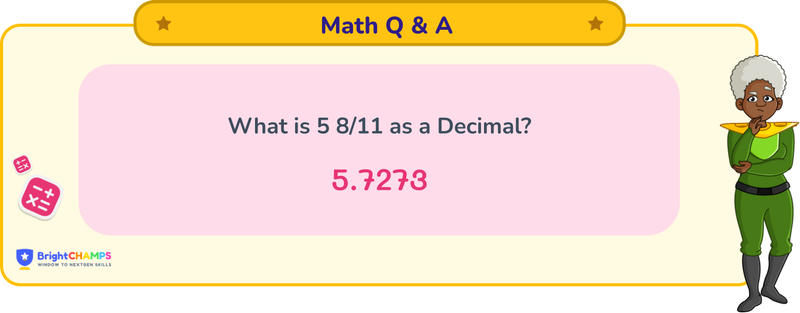Summarize this article:
 202 Learners
202 LearnersLast updated on August 5, 2025
5 8/11 as a Decimal

It is a simple question on decimal conversion. Firstly, we have to learn fractions and decimals. A fraction represents a part of the whole. It has two parts: the numerator (number on the top), here 8 represents how many parts out of the whole. The denominator (number below) shows how many parts make the whole, here it is 11. A decimal is a way to represent a number that is not whole, using a (.) or a decimal to separate the whole part from the fractional part. The numbers to the left of the decimal point represent the whole, and those to the right represent the fractional part.

What is 5 8/11 as a decimal?

Answer
5 8/11 in decimals can be written as 5.7272… It is a recurring decimal, showing it will repeat the same digits infinitely.
Explanation
To convert 5 8/11 to a decimal, we will use the division method for the fractional part and then add the whole number part. Let's see the step-by-step breakdown of the process:
Step 1: Identify the whole number, numerator, and denominator. The whole number is 5, the numerator (8) will be taken as the dividend, and the denominator (11) will be taken as the divisor.
Step 2: Divide 8 by 11. As 8 is smaller than 11, we will take the help of decimals. We will add 0 to the dividend, making 8 as 80, and add a decimal point in the quotient place.
Step 3: Now that it is 80, we can divide it by 11. Let's see how many times 11 fits into 80.
Step 4: 80 divided by 11 is approximately 7. 11 x 7 = 77. Write 7 in the quotient place and subtract 77 from 80, which gives 3.
Step 5: Bring down another 0 in the dividend place, making it 30, and then repeat the division process.
Step 6: 30 divided by 11 is approximately 2. 11 x 2 = 22. Write 2 in the quotient place and subtract 22 from 30, which gives 8.
Step 7: Repeat the process, and you will see the digits 72 repeating. The decimal representation for 8/11 is 0.7272…, and then add the whole number 5 to get 5.7272…
This process results in a recurring decimal.

Important Glossaries for 5 8/11 as a decimal
- Fraction: A numerical quantity that is not a whole number, representing a part of a whole.
- Decimal: A number that uses the base ten and includes a decimal point to separate the whole part from the fractional part.
- Numerator: The top part of a fraction, indicating how many parts of the whole are being considered.
- Denominator: The bottom part of a fraction, showing how many parts make up a whole.
- Recurring Decimal: A decimal that has one or more repeating digits after the decimal point.

Explore More math-questions
![Important Math Links Icon]() Previous to 5 8/11 as a Decimal
Previous to 5 8/11 as a Decimal
![Important Math Links Icon]() Next to 5 8/11 as a Decimal
Next to 5 8/11 as a Decimal





